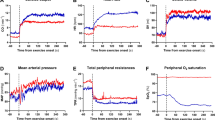Summary
The cardiovascular responses to breath-holding (BH) during short-lasting supramaximal exercise (415 W) on a cycle ergometer were investigated in 15 healthy male subjects. The arterial oxygen saturation, heart rate (HR), endtidal PO2 and PCO2 were continuously monitored. Firstly, 15 subjects performed exercise during BH, preceded by air breathing (air-BH test), and secondly, exercise without BH. Then 9 of the subjects performed the same procedure as in the air-BH test, except that all subjects breathed 100% O2 for 1 min before apnoea (O2-BH test). In 2 of these subjects, the systemic arterial blood pressure was continuously measured via a catheter in the radial artery and plasma catecholamine concentration [CA] was also measured both during the air-BH and the O2-BH tests. In the later period of the air-BH test, the high HR level became progressively depressed. This response, however, was absent in the O2-BH test. There was a late increase in the arterial blood pressure in both tests, and both tests produced hypercapnia. Only the air-BH test resulted in hypoxia, substantial hypertension and HR-depression. The increase in plasma CA was similar in both tests. The marked HR-depression demonstrated here is ascribed mainly to activation of the peripheral arterial chemoreceptors by asphyxia, and partially to baroreceptor activity due to elevated blood pressure.
Similar content being viewed by others
Explore related subjects
Discover the latest articles and news from researchers in related subjects, suggested using machine learning.References
Andersen HT (1966) Physiological adaptation in diving vertebrates. Physiol Rev 46:212–243
Asmussen E, Kristiansson NG (1968) The diving bradycardia in exercising man. Acta Physiol Scand 73:527–535
Band DM, Linton RAF (1986) The effect of potassium on carotid body chemoreceptor discharge in the anaesthetized cat. J Physiol 381:39–47
Band DM, Linton RAF (1987) The interaction of hypoxia and K+ on the carotid chemoreceptor in anaesthetized cats. J Physiol 394:65 P
Bjertnaes L, Hauge A, Kjekshus J, Søyland E (1984) Cardiovascular responses to face immersion and apnea during steady state muscle exercise. A heart catheterization study on humans. Acta Physiol Scand 120:605–612
Bristow JD, Brown EB Jr, Cunningham DJC, Goode RC, Howson MG, Sleight P (1971) The effects of hypercapnia, hypoxia and ventilation on the baroreflex regulation of the pulse interval. J Physiol 216:281–302
Daly MD, Scott MJ (1963) The cardiovascular responses to stimulation of the carotid body chemoreceptors in the dog. J Physiol 165:179–197
Eldridge FL (1974) Central neural respiratory stimulatory effect of active respiration. J Appl Physiol 37:723–735
Eyzaguirre C, Lewin J (1961) Chemoreceptor activity of the carotid body of the cat. J Physiol 159:222–237
Fitzgerald RS, Parks DC (1971) Effect of hypoxia on carotid chemoreceptor response to carbon dioxide in cats. Respir Physiol 12:218–229
Gross PM, Whipp BJ, Davidson JT, Koyal SN, Wasserman K (1976) Role of the carotid bodies in the heart rate response to breath holding in man. J Appl Physiol 41:336–340
Heistad DD, Abboud FM, Eckstein JW (1968) Vasoconstrictor response to simulated diving in man. J Appl Physiol 25:542–549
Hollenberg NK, Uvnäs B (1963) The role of the cardiovascular response in the resistance to asphyxia of avian divers. Acta Physiol Scand 58:150–161
Holm B, Sørensen SC (1972) The role of the carotid body in the diving reflex in the duck. Respir Physiol 15:302–309
Hong SK, Moore TO, Seto G, Park HK, Hiatt WR, Bernauer EM (1970) Lung volumes and apneic bradycardia in divers. J Appl Physiol 29:172–176
Hong SK, Lin YC, Lally DA, Yim BJB, Kominami N, Hong PW, Moore TO (1971) Alveolar gas exchanges and cardiovascular functions during breath holding with air. J Appl Physiol 30:540–547
Irving L (1963) Bradycardia in human divers. J Appl Physiol 18:489–491
Jones DR, Purves MJ (1970) The carotid body in the duck and the consequences of its denervation upon the cardiac responses to immersion. J Physiol 211:279–294
Katzin DB, Rubinstein EH (1974) Vagal control of heart rate during hypoxia in the cat. Proc Exp Biol Med 147:551–557
Kawakami Y, Natelson BH, DuBois AB (1967) Cardiovascular effects of face immersion and factors affecting diving reflex in man. J Appl Physiol 23:964–970
Kontos HA, Vetrovec GW, Richardson DW (1970) Role of carotid chemoreceptors in circulatory response to hypoxia in dogs. J Appl Physiol 28:561–565
Linton RAF, Lim M, Wolff CB, Wilmshurst P, Band DM (1984) Arterial plasma potassium measured continuously during exercise in man. Clin Sci 67:427–431
Moore TO, Elsner R, Lin YC, Lally DA, Hong SK (1973) Effects of alveolar PO2 and PCO2 on apneic bradycardia in man. J Appl Physiol 34:759–798
Olsen CR, Fanestil DD, Scholander PF (1962) Some effects of breath holding and apneic underwater diving on cardiac rhythm in man. J Appl Physiol 17:461–466
Paulev P-E (1969) Respiratory and cardiovascular effects of breath-holding. Acta Physiol Scand [Suppl] 324:1–116
Scholander PF, Hammel HT, LeMessurier H, Hemmingsen E, Garey W (1962) Circulatory adjustment in pearl divers. J Appl Physiol 17:184–190
Richardson DW, Wasserman AJ, Patterson JL Jr (1961) General and regional circulatory responses to change in blood pH and carbon dioxide tension. J Clin Invest 40:31–43
Strauss MB (1970) Physiological aspects of mammalian breath hold diving: a review. Aerospace Med 41:1362–1381
Author information
Authors and Affiliations
Rights and permissions
About this article
Cite this article
Ahn, B., Nishibayashi, Y., Okita, S. et al. Heart rate response to breath-holding during supramaximal exercise. Europ. J. Appl. Physiol. 59, 146–151 (1989). https://doi.org/10.1007/BF02396593
Accepted:
Issue Date:
DOI: https://doi.org/10.1007/BF02396593




